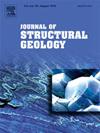Deformation style and fluid flow behaviour in a faulted siliciclastic-carbonate sequence
IF 2.9
2区 地球科学
Q2 GEOSCIENCES, MULTIDISCIPLINARY
引用次数: 0
Abstract
Understanding fluid flow behaviour of faults is important for resource exploitation and management. Most studies analysing fluid flow behaviour in fault zones focus on either high-porosity or low-porosity sequences. In this study, we analyse various mechanical layers within alternating siliciclastic-carbonate sequences in fault zones in the Oligo-Miocene Logudoro basin, located in northern Sardinia (Italy). We combined a variety of methods, including field measurements of structures, in-situ permeability and Schmidt Hammer rebound measurements converted to uniaxial compressive strength. Furthermore, we performed thin section analysis, to characterize grain size, porosity, and mineral compositions. We used the gathered data to model the fluid flow conditions within deformation patterns present in one fault-zone. Deformation styles are related to mechanical properties of the rocks at the time of faulting, juxtaposition and differences in intergranular space and porosity in sandstones. The permeability is influenced by the presence of deformation structures such as fractures (high permeability), compactional shear bands (low permeability) and fault rocks within fault core (high and/or low permeability). The fluid flow model highlights the significant influence of deformation bands on the flow field and hydraulic gradient, demonstrating the importance of including these structures in the analysis.
断裂硅酸-碳酸盐岩层序的变形样式和流体流动特征
了解断层流体的流动特性对资源开发和管理具有重要意义。大多数分析断裂带流体流动特性的研究都集中在高孔隙度或低孔隙度层序上。在这项研究中,我们分析了位于意大利撒丁岛北部渐近-中新世Logudoro盆地断裂带中硅塑性-碳酸盐交替层序中的各种机械层。我们结合了多种方法,包括现场测量结构、原位渗透率和转换为单轴抗压强度的施密特锤回弹测量。此外,我们进行了薄片分析,以表征颗粒尺寸,孔隙度和矿物成分。我们使用收集到的数据来模拟一个断层带中存在的变形模式内的流体流动条件。变形类型与断裂时岩石的力学性质、并置、粒间空间和砂岩孔隙度的差异有关。渗透率受裂缝(高渗透)、压实剪切带(低渗透)和断层岩心内断层岩石(高和/或低渗透)等变形构造的影响。流体流动模型突出了变形带对流场和水力梯度的显著影响,表明了将这些结构纳入分析的重要性。
本文章由计算机程序翻译,如有差异,请以英文原文为准。
求助全文
约1分钟内获得全文
求助全文
来源期刊

Journal of Structural Geology
地学-地球科学综合
CiteScore
6.00
自引率
19.40%
发文量
192
审稿时长
15.7 weeks
期刊介绍:
The Journal of Structural Geology publishes process-oriented investigations about structural geology using appropriate combinations of analog and digital field data, seismic reflection data, satellite-derived data, geometric analysis, kinematic analysis, laboratory experiments, computer visualizations, and analogue or numerical modelling on all scales. Contributions are encouraged to draw perspectives from rheology, rock mechanics, geophysics,metamorphism, sedimentology, petroleum geology, economic geology, geodynamics, planetary geology, tectonics and neotectonics to provide a more powerful understanding of deformation processes and systems. Given the visual nature of the discipline, supplementary materials that portray the data and analysis in 3-D or quasi 3-D manners, including the use of videos, and/or graphical abstracts can significantly strengthen the impact of contributions.
 求助内容:
求助内容: 应助结果提醒方式:
应助结果提醒方式:


